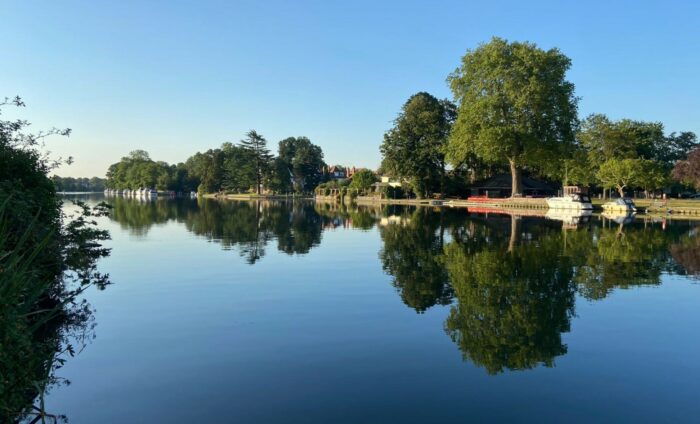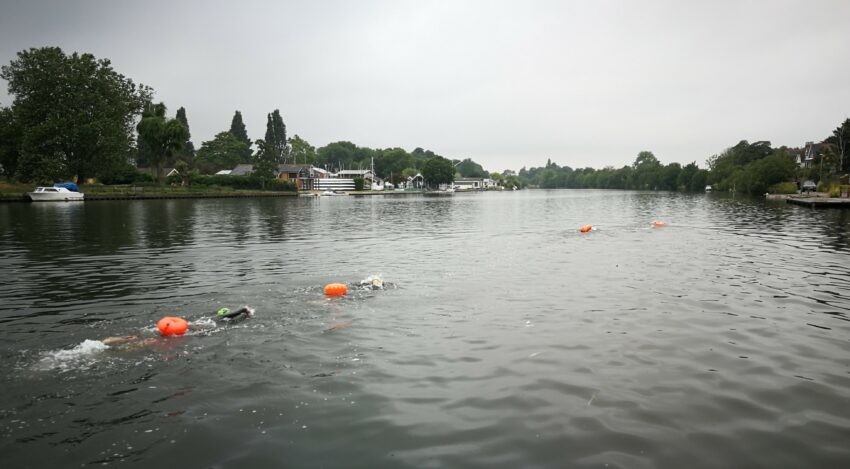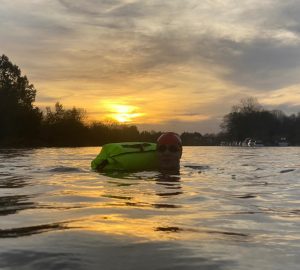
The Joy of Thames Swimming – and some safety tips
I’ve lived close to the Thames, near Teddington Lock, for 20 years, but – until this summer – I’ve always been wary about swimming in it. When I have swum, it’s mostly been short dips, often head-up breaststroke, or in events further up river, where there’s less chance of pollution. However, this July, I swam more than 80km on the stretch between Teddington Lock and Kingston Bridge. And it’s been amazing. So what’s changed?
The stimulus for so much river swimming was lockdown and the closure of swimming pools. As a member of a local masters swimming club, I’ve always done most of my training in a pool, even in the summer, while doing open water swims at weekends – and there was a long list of excuses why regular swimming training in the Thames didn’t seem like a good idea, including:
- It’s dirty (although the perception is worse than the reality)
- It’s polluted (again, perception is worse than reality, but I have once got ill after swimming in it)
- Dangerous currents that can pull even the strongest swimmer under (maybe, around weirs, or perhaps around bridge piers in the tidal section but otherwise I think this is a scare story)
- It’s dangerously cold, even in summer (this isn’t true, although it’s something the emergency services still keep telling us)
- You might get hit by a boat (this is a real risk, so take precautions)
- Access was difficult (this used to be the case when there was a large number of illegally moored boats on this section of the river, but isn’t any longer)
- I had nobody to swim with (the people I swim with preferred the pool for training and I, mostly, stick to the “never swim alone” rule)
The only excuse that had much substance was the final one, and pool closures fixed that for me. This summer I’ve had plenty of people keen to join me for Thames swims. In many ways, it’s been the highlight of lockdown. Even as an experienced outdoor swimmer, and knowing that the river was not as polluted, dirty, cold and dangerous as some people would have us believe, I still needed an extra push to get started. And now I don’t want to stop. Several of the people I swim with have asked if we can do this every summer, even when pools re-open.

Use a tow float
We typically swim in the morning, before work (as we used to in the pool). This is often the best time of day to be out in the water. Although it can be busy with rowers, scullers and kayakers, these are all regular and respectful river users. They may move fast and almost silently, but they are predicable and know what they are doing. We make sure we use tow floats so they can see us, and they (usually) give us plenty of space. Later in the day, particularly on sunny afternoons, you get the (occasionally inebriated) recreational motorboat users. Shall we just say that some of these are a little less predictable.
Another enjoyable thing about swimming in the river is the distance you can swim in one direction. On a Saturday morning, we typically swim 2.5km upstream on one side of the river, turn around and swim 2.5km back again on the other. Sighting is easy (follow the bank) and you don’t have to worry about turns every 25m (like in the pool) or 200m or so (as you often have to do at lake venues). I’ve found this makes it easy to get into a steady, meditative rhythm while swimming.
I’ve also enjoyed the different moods of the river and the longer term changes with the seasons. When we started, the water temperature was in the low teens, the current was stronger and the water murkier. It’s become warmer (22 degrees at times), gentler and clearer moving into summer. I’ve loved seeing the wildlife and the young of the various water birds, and I’m always excited to see a heron, even though they’ve become quite common. The river changes throughout the day too. The direction of the sun makes a surprising difference to what you see and notice. And then the wind changes things. The water can get remarkably choppy for such a sheltered stretch of water. I’ve also noticed, strangely, that we sometimes have the best swims on the days when it looks least inviting.
Oh, and I’ve made a few new friends, who’ve seen us swimming and asked to join, and I’ve got to know old friends better.
Anyway, I thoroughly recommend swimming in the Thames. See below for how to make the most of it.

Harry the Heron (or was it Henry, or Henrietta?)
Swim with other people
You need to maintain social distance obviously, but swimming with other people adds to the fun, makes you more visible in the water and means help is available in case of an emergency.
Plan your entry and exit, and get in carefully
Many parts of the Thames have steep (vertical) man-made banks where it can be difficult to get out. Look for places where you can sit on the edge and slide in gently, and ideally stand for a minute or two until you adjust to the water temperature.
Use a tow float
A lot of people use the river and while swimmers are becoming more common, not everyone expects to find them in the water or looks out for them. A tow float makes a massive difference to your chances of being seen.
Swim on the right
This one is debatable. The general rule is for all river traffic to travel on the right. There is an argument that swimmers should swim on the left so they can see and hence avoid oncoming traffic and one sculler even advised us to do this. However, every time we’ve done it, other scullers and rowers have complained. We now stick to the right and regular river users are accustomed to finding us there.
Swim close to the bank – but not too close
This is related to the above. If you’re close to the bank, you’re less likely to be in the path of boats approaching you from behind. However, you don’t want to be so close that you swim into jetties or trees.
Watch out for fishing lines
Fishing season in the Thames starts on 15 June. You won’t see the lines but watch out of the anglers and swim wide (but check behind first to make sure nothing is coming)
Ask someone to paddle with you
Having someone paddle with you on a SUP or kayak is a great way to improve your safety as they will see and hear more than you, and will be more visible – and they can help you spot the angers.
Be courteous to other river users
Other river users also love the river and their sport just as much as you do. Don’t spoil their day.
Keep the noise down, especially early in the morning
Socially distanced swimmers wearing ear plugs can be very loud when they stop to chat. There are people living in house boats along the river who don’t appreciate being woken up.
Take extra care in the tidal section
Downstream of Teddington Lock, the Thames is tidal. The depth can change rapidly, meaning your entry spot may be submerged or high and dry out of reach by the time you return. The current is stronger and changes direction twice daily. The river is used by bigger and more powerful boats. Swimming is not allowed downstream of Putney Bridge.








